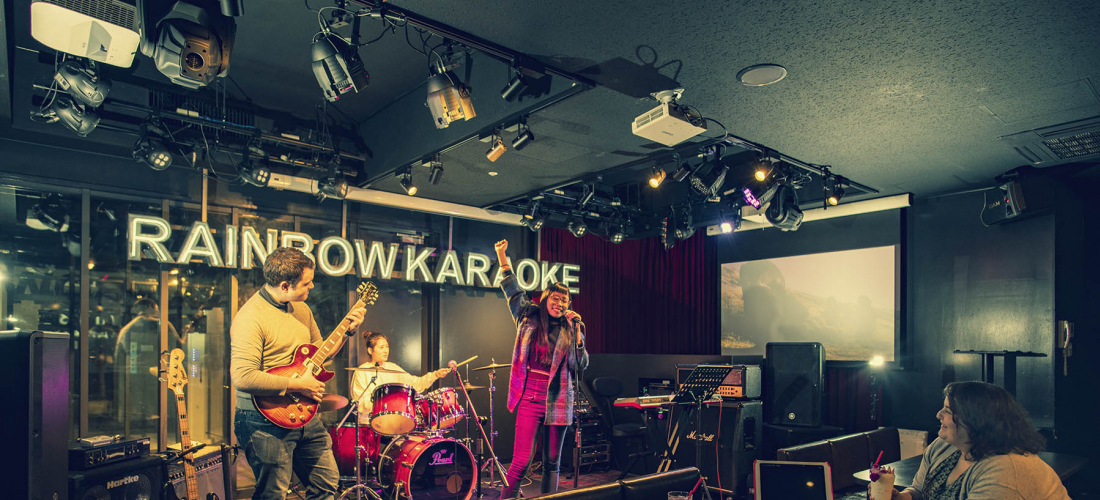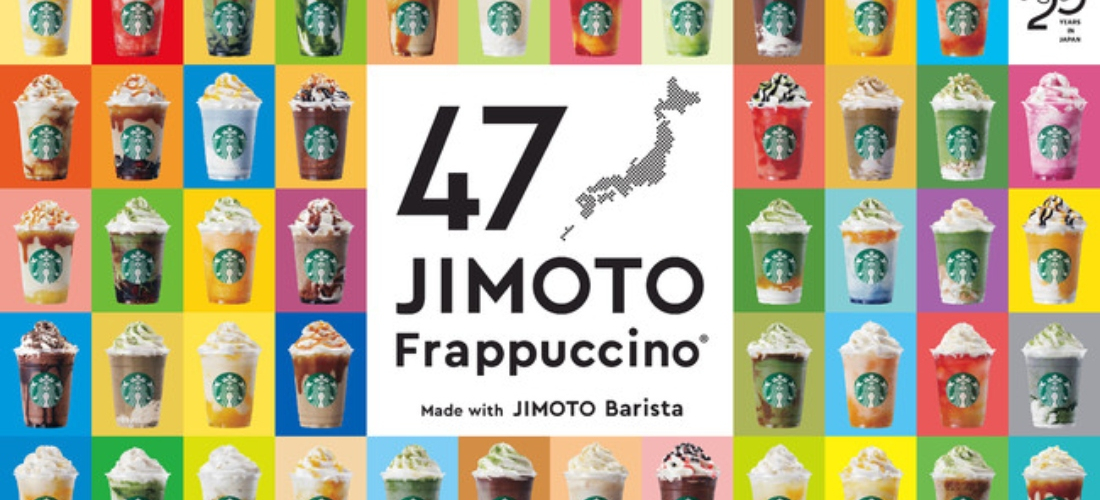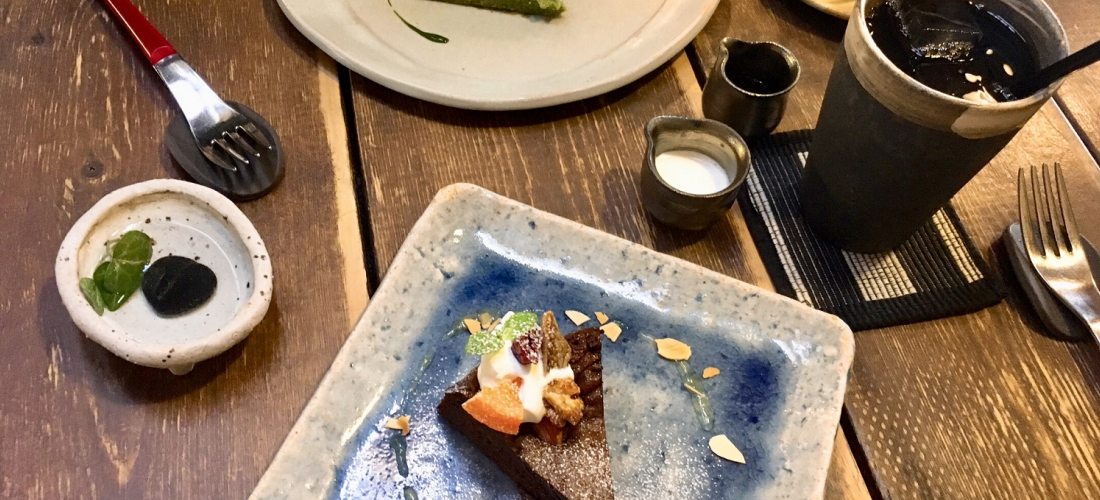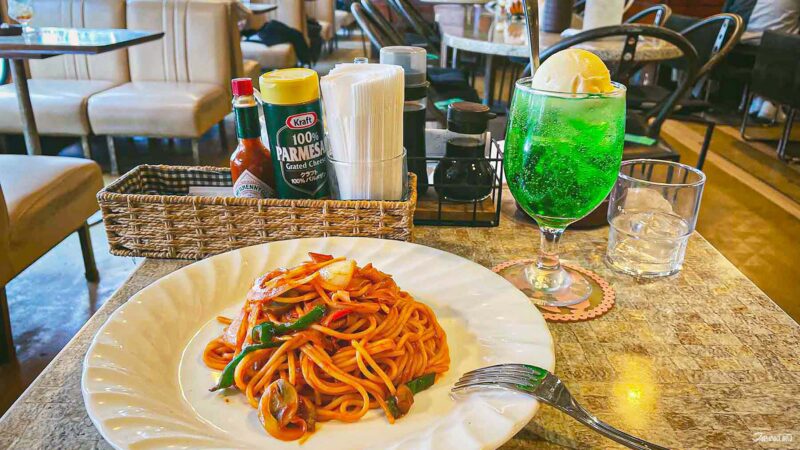CONTENTS
These retro Tokyo cafes have all the nostalgic Japanese kissaten vibes you could dream of. Visit Ueno to soak up the classic cafe atmosphere on your next trip to Japan!
Why Does Ueno Have So Many Retro “Kissaten” Cafes?
The classic “kissaten” (喫茶店) is a Japanese staple: an old-fashioned cafe serving coffee and tea alongside Japanese-style Western food like napolitan pasta (made with ketchup) and thick-cut white bread toast, often including a dessert menu with treats like melon soda ice cream floats (called “cream sodas” in Japan). From the menu to the interior decoration, and of course the nostalgic smokey haze of cigarettes, these old-school cafes are a crystalization of Japan’s Showa-era culture, a period lasting from 1926 to 1989. And all of that means that the vintage stereotypes have piled one upon another over the many years these shops have been in business, creating deep wells of nostalgia. So of course, it’s pretty fun for foreign visitors to jump into as well! As an important part of Japanese culture, kissaten can be found all around the country, but there’s no doubt that Ueno is one of the easiest places for visiting travelers to find a goldmine of cute retro cafes gathered in one area.
So why exactly are there all these kissaten in Ueno? Well, the reason dates back (in part) all the way to Japan’s Edo period (1603-1868), when the city of Edo (present-day Tokyo) became the capital of Japan, and the area largely divided itself into two parts: the high ground called Yamanote, and the lowlands called Shitamachi. While Yamanote was generally where you might find society rich and famous, Shitamachi was more working class, and even today those distinctions carry some weight. Smack-dab in the middle of the Shitamachi area, modern-day Ueno is a thriving – but not exactly wealthy – neighborhood, which means it has escaped some of the gentrification found elsewhere in the city. This means fewer city beautification projects, and more old businesses hanging on for as long as their customer base will let them, giving old-fashioned kissaten a chance to survive and thrive. Put simply, Ueno has a wealth of old-fashioned retro cafes because Ueno itself is a little bit old-fashioned and retro, so it’s a great place to indulge in a little classic Japanese culture.
Cafe ① Gyaran (Galant) Coffee Shop (ギャランコーヒーショップ)
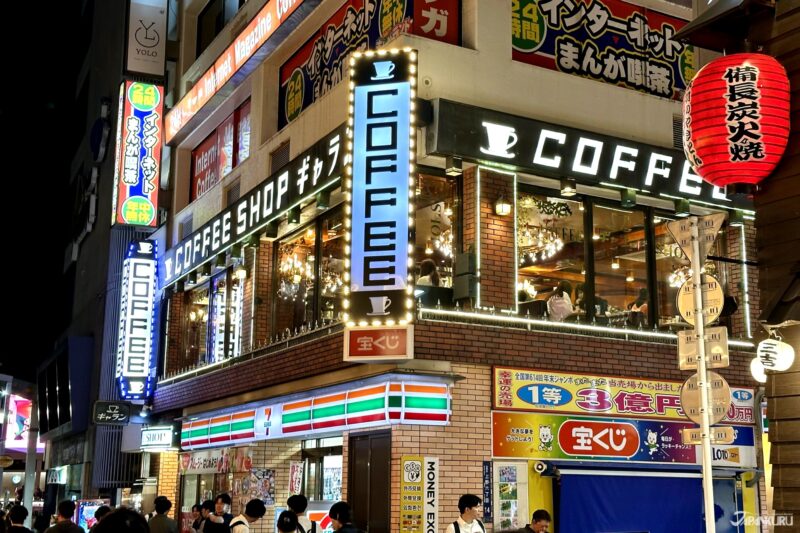
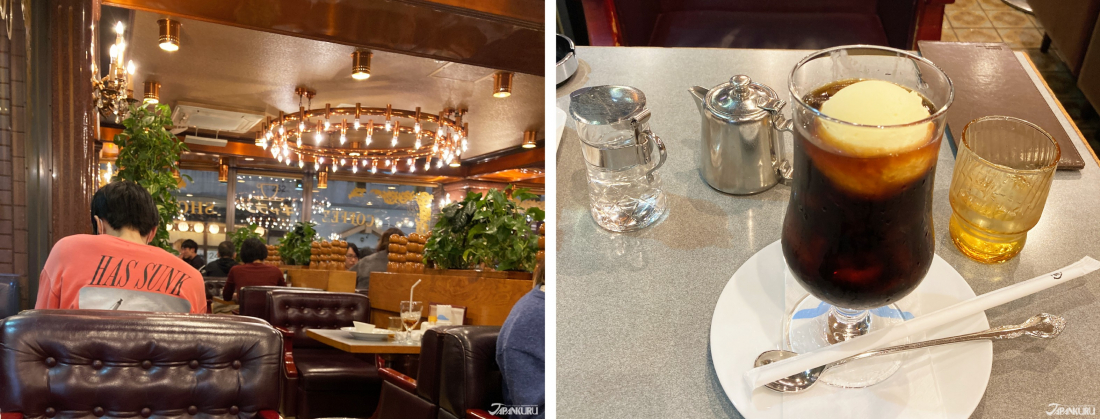
Across the street from Ueno’s raised train tracks and tucked away in the busy heart of the Ameyoko shopping and entertainment district, Gyaran (technically “Galant” but almost never referred to as such) is the epitome of the glitzy Ueno kissaten. Climb the stairs past the glowing signs outside, choose from the menu of Showa-era classics, and soak up the noisy hum of other customers who come from near and far. When it comes to food and drink there’s a lot to choose from, from breakfast sandwiches served with small cups of black coffee to picture-perfect kissaten-style green melon “cream sodas,” plus parfaits, omu-rice, and an assortment of other yoshoku (洋食, Japanese-style Western food) dishes and desserts. But if you’ve never been to a Japanese kissaten before and you want to find out what they’re like, it’s the ambience at Gyaran that makes it the perfect choice. But non-smokers beware – like most kissaten, there are still ashtrays on every table, and there is no non-smoking section!
Gyaran (Galant) Coffee Shop (ギャランコーヒーショップ)
6-14-4 Ueno, Taito City, Tokyo
Hours: 8:00 – 10:30
Cafe ② Coffee Oujo (珈琲王城)
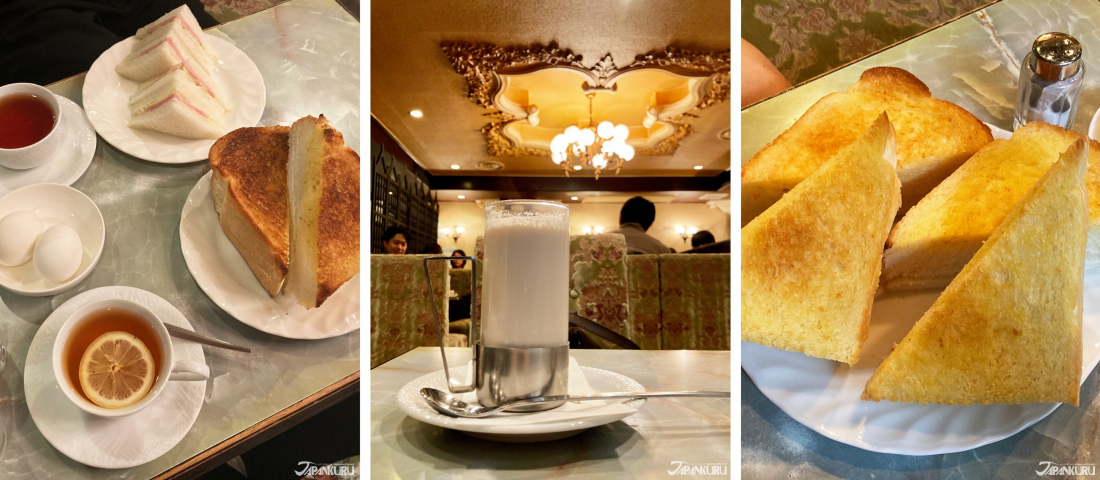
This Ueno favorite often has lines way out the door on weekends, but if you can grab a table (we recommend weekdays) then you’ll be delighted by the elegant interior, with the decorative molded ceiling and the richly patterned seating. Although there’s no doubt Oujo has been around a while, its exact date of establishment is actually unknown, since the third-generation owner says that records from before the shop moved to its current location have been lost. However, records do remain from the shop’s move in the year 1975, so Oujo has probably been in business for over 50 years – and the shop has changed very little in all those decades. A younger crowd has descended on Oujo in recent years, but customers are still ordering the same kissaten classics: bright red napolitan pasta, and tall parfaits with vanilla ice cream, mandarin orange slices, and plenty of chocolate sauce-covered whipped cream (which would probably be called sundaes in the English-speaking world). The Japankuru team also recommends their breakfast hours, when they serve up pots of hot tea and coffee with thick slices of white fluffy toast. Or for something more unique, the third-generation owner is also a third-generation expert in traditional Japanese “kanpo” (漢方) medicine, and so the shop offers a kanpo-influenced menu with items like brown sugar ginger milk and jujube milk as well!
▶︎ Oujo also advertises its non-smoking status these days, which makes it a good option for anyone who wants to avoid the standard clouds of smoke that are still common in kissaten!
Coffee Oujo (珈琲王城)
6-8-15 Ueno, Taito City, Tokyo
Hours: 8:00 – 19:00
Official Website (jp) | Official X (Twitter) | Official Instagram
Cafe ③ Cafe Kojo (喫茶 古城)

As far as we’re aware, Oujo and Kojo are not connected in any way, but the “jo” in the names actually shares the same meaning. Oujo means “King’s Castle” whereas Kojo means “Old Castle,” and you can certainly understand where the name comes from as soon as you descend the shop’s dark and mysterious stairs. From stained glass portraits featuring medieval knights and Rococo nobility to walls covered in slabs of smooth marble, the dramatic interior does look like something out of a European castle fever dream. Closed on Sundays and perhaps most crowded during weekday lunch hours, it seems like Kojo hasn’t become a go-to spot among the younger crowd of kissaten lovers quite yet, and it’s still most popular with local office workers who stop in for a quick lunch of Japanese curry rice or the daily pasta dish, and older locals who enjoy a leisurely breakfast of simple sandwiches, coffee, and their morning cigarette. Of course, the food isn’t really the focal point at this old castle cafe – it’s worth a visit just for the vibes!
Cafe Kojo (喫茶 古城)
3-39-10 Higashiueno, Taito City, Tokyo
Hours: 9:00 – 20:00 (closed Sundays, holidays)
Official X (Twitter) | Official Instagram
Cafe ④ Katsura Coffee House (珈琲店 桂)
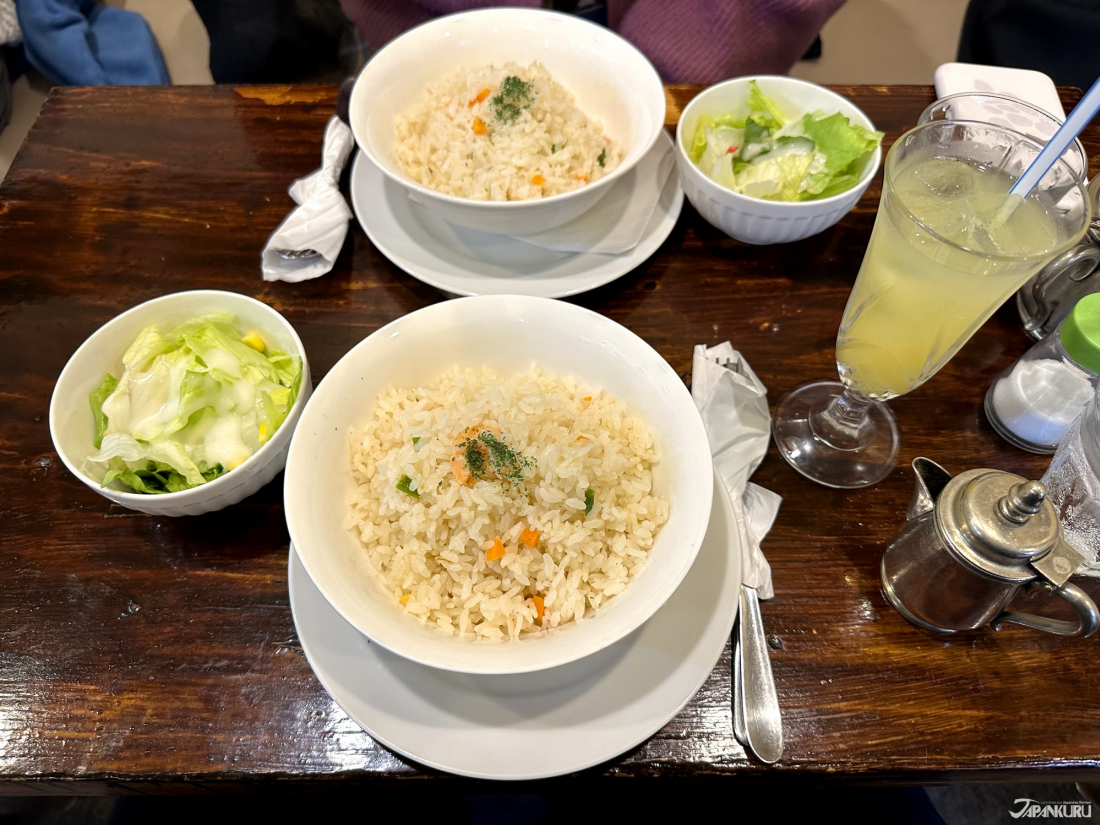
Ask a Ueno local to meet you at Katsura, and their immediate response will probably be “Great! Which one?” Because this extremely local “chain” actually has three different locations, all within a five-minute walk of each other. Far from the dramatic interiors and glittering chandeliers of many of Ueno’s popular kissaten, all three of Katsura’s locations have a much more homey feel, with simple furniture, books along the wall, and shelves displaying each shop’s collection of tea and coffee cups. Although popular with locals at lunchtime, these little cafes must be a little too casual and low-key to attract customers from other parts of the city, because you’re not likely to have to line up to get a seat! But if you’re looking for a relaxed home-town feel, Katsura is an obvious choice in Ueno. Try the coffee with one of their cakes (baked in-house), or sit down for a dish of their popular rice pilaf! (If you like really sour lemonade, don’t miss the chance to order a glass of fresh-squeezed lemon juice, which is literally just that.) Each shop is a little different, but the cozy atmosphere in each one is ideal for a little escape from the busy streets of Ueno. You might be tempted to visit all three locations!
Katsura Coffee House (珈琲店 桂)
Katsura Taito City Hall Location, 4-3-10 Higashiueno, Taito City, Tokyo
Hours: weekdays 7:30 – 19:00 | weekends 8:30 – 18:00
Katsura Showa-dori Corner Location, 7-12-8 Ueno, Taito City, Tokyo
Hours: 8:00 – 17:00 (closed Saturdays & Sundays)
Katsura Ueno Academy Location, 1-5-2 Kitaueno, Taito City, Tokyo
Hours: 9:00 – 19:00 (~18:00 on Saturdays, closed Sundays)
Travel Back in Time at These Showa-Era Ueno Cafes
Each one unique, but each a throwback to another era, the retro kissaten found all over Ueno are a true treat for anyone interested in Tokyo in the Showa period or anyone who loves all the unique niche cultural phenomena that make Japan so exciting to explore. Whether you go for elegant chandeliers or themed interior design that verges on wacky, classic green melon soda floats or kanpo-inspired jujube milk, there’s a lot of fun to be found at Ueno’s many retro cafes. Don’t miss them next time you’re in the area!
For more info and updates from Japan, check Japankuru for new articles, and don’t forget to follow us on X (Twitter), Instagram, and Facebook!
Details
NAME:Kissaten (喫茶店)
Half a lifetime ago I came to Japan for a semester abroad... and I never left. I guess I really like the place! I spent my first few years in Japan living in the middle of nowhere, so I'd love to hear your Tokyo recommendations via Japan's social media accounts!
COMMENT
FEATURED MEDIA
VIEW MOREMAP OF JAPAN
SEARCH BY REGION

LATEST
VIEW MOREEVENT CALENDAR
VIEW MOREMOST POPULAR
 Tokyo Winter Recommendation: Don’t Miss Tokyo Mega Illumination, Japan’s #1 Light Show
Tokyo Winter Recommendation: Don’t Miss Tokyo Mega Illumination, Japan’s #1 Light Show ป้ายยาสินค้าน่าซื้อในร้านขายยาญี่ปุ่น | KOWA ผลิตภัณฑ์เพื่อสุขภาพสำหรับคนยุคใหม่
ป้ายยาสินค้าน่าซื้อในร้านขายยาญี่ปุ่น | KOWA ผลิตภัณฑ์เพื่อสุขภาพสำหรับคนยุคใหม่ Okinawa Family Road Trip: Japanese Glasses Shopping at San-A Urasoe West Coast PARCO CITY, Discount Coupons, & Okinawa Sightseeing with JINS
Okinawa Family Road Trip: Japanese Glasses Shopping at San-A Urasoe West Coast PARCO CITY, Discount Coupons, & Okinawa Sightseeing with JINS

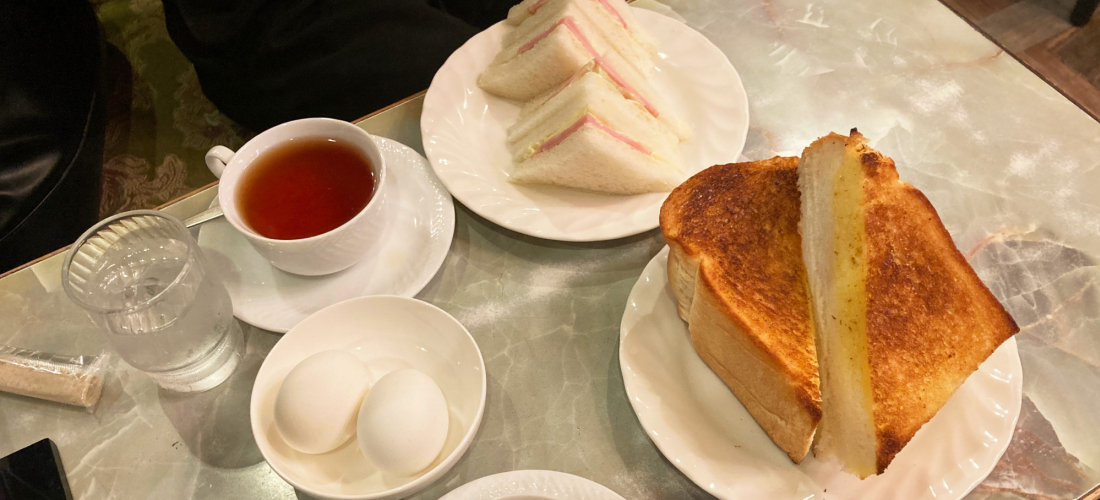
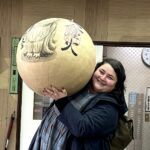



 >> Find out more at Japankuru.com! (link in bio)
#
>> Find out more at Japankuru.com! (link in bio)
#





 The Robot Restaurant is gone, but the Samurai Restaurant is here to take its place. Check it out, and don't forget your coupon!
The Robot Restaurant is gone, but the Samurai Restaurant is here to take its place. Check it out, and don't forget your coupon!
 신주쿠의 명소 로봇 레스토랑이 사무라이 레스토랑으로 부활! 절찬 쿠폰 발급중
신주쿠의 명소 로봇 레스토랑이 사무라이 레스토랑으로 부활! 절찬 쿠폰 발급중
 18歲以上才能入場的歌舞秀,和你想的不一樣!拿好優惠券去看看~
#tokyo #shinjuku #samurairestaurant #robotrestaurant #tokyotrip #도쿄여행 #신주쿠 #사무라이레스토랑 #이색체험 #할인이벤트 #歌舞伎町 #東京景點 #武士餐廳 #日本表演 #日本文化體驗 #japankuru #japantrip #japantravel #japanlovers #japan_of_insta
18歲以上才能入場的歌舞秀,和你想的不一樣!拿好優惠券去看看~
#tokyo #shinjuku #samurairestaurant #robotrestaurant #tokyotrip #도쿄여행 #신주쿠 #사무라이레스토랑 #이색체험 #할인이벤트 #歌舞伎町 #東京景點 #武士餐廳 #日本表演 #日本文化體驗 #japankuru #japantrip #japantravel #japanlovers #japan_of_insta
 코지마 x 빅 카메라 쿠폰으로 일본 가전 제품 쇼핑하기
#pr #japankuru #japanshopping #kojima #biccamera #japaneseskincare #yaman #dji #osmopocket3 #skincaredevice #日本購物 #美容儀 #相機 #雅萌 #日本家電 #일본여행 #면세 #여행꿀팁 #일본쇼핑리스트 #쿠폰 #일본쇼핑 #일본브랜드 #할인 #코지마 #빅카메라 #japankurucoupon
코지마 x 빅 카메라 쿠폰으로 일본 가전 제품 쇼핑하기
#pr #japankuru #japanshopping #kojima #biccamera #japaneseskincare #yaman #dji #osmopocket3 #skincaredevice #日本購物 #美容儀 #相機 #雅萌 #日本家電 #일본여행 #면세 #여행꿀팁 #일본쇼핑리스트 #쿠폰 #일본쇼핑 #일본브랜드 #할인 #코지마 #빅카메라 #japankurucoupon
































 Oita Hello Kitty Airport
Oita Hello Kitty Airport  Lands April 13th
Lands April 13th









